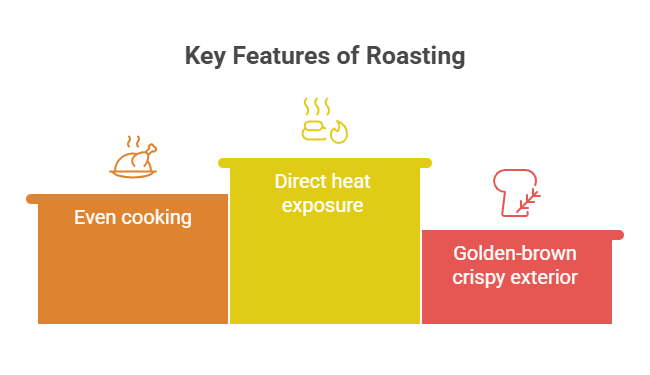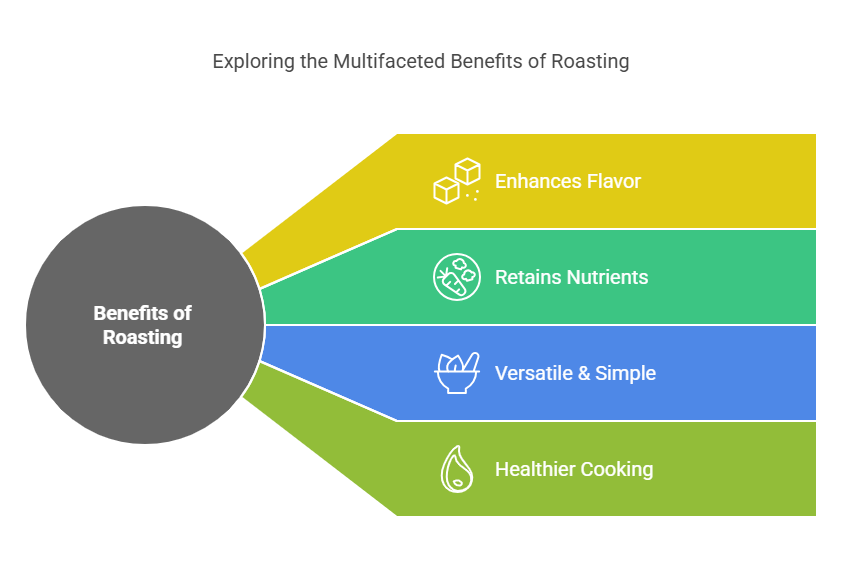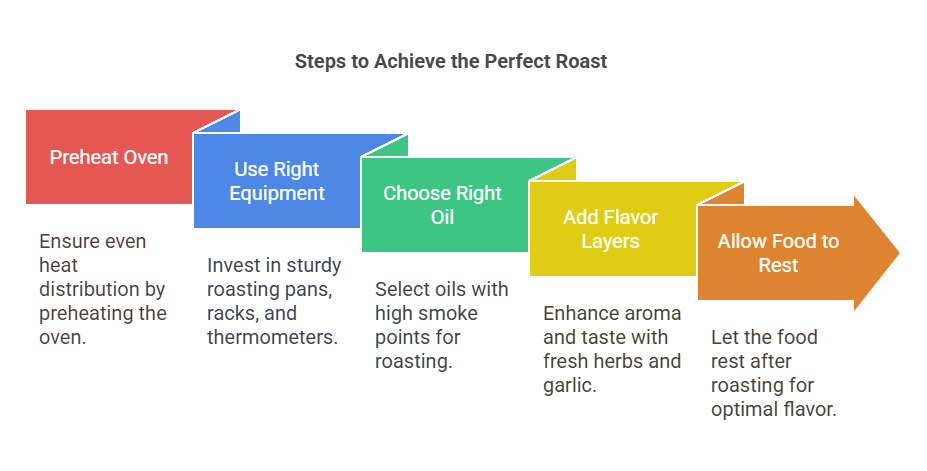Roasting technique is more than just a cooking method—it’s an art that has been perfected over centuries. From achieving tender roasts for Sunday dinners to creating perfectly caramelized vegetables, roasting elevates simple ingredients into something extraordinary. Whether you’re a home cook or an aspiring chef, understanding roasting techniques will add depth to your culinary repertoire.
This guide dives into the details of roasting to ensure that you can achieve flawless results every time. Learn its history, techniques, and tips, and discover why roasting remains one of the most versatile and indispensable dry heat cooking methods.
What is Roasting technique?
Roasting technique is a dry heat cooking technique that involves cooking food in an uncovered environment, often an oven, at a consistent temperature. This method allows hot, circulating air to evenly cook and brown the food, enhancing its natural flavors. Roasting is excellent for a variety of ingredients, from protein-heavy dishes like roasted chicken or beef to plant-based options like root vegetables.
Key Features of Roasting technique:
- Direct heat exposure ensures surface caramelization that enhances flavor through the Maillard reaction.
- Even cooking makes it ideal for large cuts of meat or dense vegetables.
- Perfect for dishes where a golden-brown, crispy exterior and tender inside are desired.
Whether it’s a holiday turkey or perfectly roasted sweet potatoes, this technique transforms everyday ingredients into flavorful masterpieces.

A Brief History of Roasting Technique
The Early Beginnings
Roasting is likely one of the oldest cooking techniques, dating back to when early humans cooked food over open flames. It was a practical method to make food more palatable and easier to digest.
Cultural Evolution
- Medieval Europe: Roasting was often done on spits over open fires, a labor-intensive process reserved for meats.
- Asia: Adaptations such as clay ovens (tandoors) brought roasts with smoky, flavorful profiles.
- Modern Cooking: The invention of ovens popularized roasting in home kitchens, making it a convenient and staple cooking method worldwide.
Understanding Roasting Techniques
Not all roasting is created equal! Here’s a breakdown of the main approaches:
Types of Roasting Technique
- Dry Roasting:
- No additional liquid is used.
- Ideal for achieving crispy exteriors (e.g., roasted nuts or vegetables).
- Moist Roasting:
- Incorporates some liquid, such as broth or wine, to keep the food moist.
- Commonly used for larger cuts of meats like pot roasts.

Temperature Matters
- Low-Temperature Roasting (250°F–300°F): Great for large cuts of meat that need slow, even cooking for tenderness.
- High-Temperature Roasting (400°F–450°F): Perfect for creating crispy skins and surfaces, like roasted vegetables or whole poultry.
Pro Tip: Begin with high-temperature roasting for browning, then reduce to low temperatures to finish cooking evenly.
Open vs. Closed Roasting Technique
- Open Roasting: Commonly done on a rack with air circulating around the food. Best for crispy textures.
- Closed Roasting: Done in a covered dish or foil packet to trap moisture.
Benefits of Roasting
Why choose roasting over other methods? Here are the highlights:
- Enhances Flavor: Roasting caramelizes sugars and intensifies flavors naturally present in ingredients.
- Retains Nutrients: Unlike boiling or frying, roasting preserves the nutritional value of vegetables and proteins with minimal nutrient loss.
- Versatile & Simple: Whether it’s poultry, vegetables, or even fruits, roasting works for a diverse range of ingredients.
- Healthier Cooking: Minimal oil is required, making it a healthier technique compared to frying.

Common Roasting Mistakes & How to Avoid Them
Even seasoned cooks can struggle with roasting. Keep these tips in mind to avoid common pitfalls:
- Overcooking or Undercooking: Always use a meat thermometer to ensure perfect doneness.
- Skipping Preheating: Preheat the oven to ensure even cooking from the start.
- Overcrowding the Pan: Leave enough space for air to circulate; otherwise, food will steam instead of roast.
- Poor Seasoning: Don’t forget to generously season your ingredients before roasting—the oven doesn’t fix bland food!
- Neglecting Rest Time: Always allow meats to rest post-roasting for juices to redistribute.
Quick Fix: Use visual cues like golden-brown edges for vegetables or juices running clear for meats as signs of doneness.
Tips for Achieving the Perfect Roast
Want to master the perfect roast? Use these professional techniques:
- Preheating is Key: Always preheat your oven for even heat distribution.
- Use the Right Equipment: Invest in sturdy roasting pans, racks, and thermometers.
- Choose the Right Oil: Use oils with high smoke points, such as avocado or grapeseed oil, for high-temperature roasting.
- Flavor Layers Matter: Add fresh herbs, citrus, or garlic to elevate the aroma and taste.
- Don’t Rush the Finish: Allow food to rest after roasting (5–15 minutes, depending on size).

Roasting Recipes for Inspiration
- Classic Roast Chicken: Tender, juicy chicken with crispy golden skin. Serve with rosemary and lemon.
- Perfect Roasted Vegetables: Carrots, parsnips, and Brussels sprouts tossed in olive oil, salt, and pepper, caramelized to perfection.
- Slow-Roasted Beef Chuck: Fall-apart tender beef with a savory crust. Perfect for family dinners.
FAQs About Roasting Technique
Q1. How is Roasting Different from Baking?
While both use dry heat, baking typically involves a closed container or precise chemical reactions (e.g., bread), whereas roasting focuses on browning and savory preparations.
Q2. What’s the Ideal Temperature Range for Roasting?
Most foods roast well between 375°F and 450°F, but it depends on the ingredient and desired result.
Q3. Can I Roast Without an Oven?
Yes! Look into stovetop roasting using heavy cast-iron skillets or outdoor options like grilling for similar effects.
Closing Thoughts
Roasting is more than a technique—it’s a skill worth mastering for anyone serious about home cooking. Its ability to build layers of flavor, retain nutrients, and simplify complex meals makes it a favorite among chefs and food enthusiasts alike.
Looking to elevate your cooking game? Start experimenting with different roasting techniques and ingredients today to find what works best for you.
📌 Stay connected with us!
- Follow us on Instagram: @RoastedKitchen25 for daily baking inspiration.
- Tag us in your creations using #RoastedKitchenRoast—we’d love to see what you make!
- Subscribe to our newsletter for exclusive recipes, expert tips, and kitchen hacks straight to your inbox!
➡️ Visit our Roasting Recipes Page and start your delicious adventure today!

Hi, I’m Mayaz Ahsan!
As a passionate cook, storyteller, and food enthusiast, I combine my love for travel, farming, reading, and teaching to bring you insightful culinary tips and stories. Welcome to Roasted Kitchen – I’m thrilled to share this journey with you!










 Subscribe to our free newsletter for tips, tutorials, and insights!
Subscribe to our free newsletter for tips, tutorials, and insights!